Next Friday I will be flying out to Whitehorse, Yukon Territory in the North of Canada to take part in this years Yukon River Quest, which is also known as the “Race to the Midnight Sun” and is billed as “The most spectacular paddling race in the world!”

I will be heading out for this years race with two teams, one of which is from London Irish Premier Rugby Club, and the other is from Interserve, which is one of the world’s foremost support services and construction companies. I will be member of the team from London Irish Rugby comprising of Toby Booth, Justin Bishop, Neil Hatley, Gavin Gleave, Tony Cilia and of course myself. As well as successfully completing the race our aim is to raise money for our chosen charity Help for Heroes, which helps wounded service men and women that have been injured whilst serving in Iraq or Afghanistan. You can visit their site at www.helpforheroes.org.uk and find out more about the fantastic work they do.
The 14th Annual Yukon River Quest starts to the east of Alaska at Whitehorse, Yukon on the 27th June 2012 finishing some 450miles/745km later on Armed Services Day, the 1st July just below the Arctic Circle, at Dawson City, Yukon. Athletes paddling canoe/kayak, solo, tandem and crewed join from around the world to test their endurance, racing day and night along the 450miles/745km of rugged river shoreline to the Klondike in the most spectacular paddling race in the world.
The Yukon River Quest had its birth in the Dyea to Dawson Centennial Race to the Klondike. In 1997 and 1998, up to 50 two-person teams hiked over the 33-mile Chilkoot Trail from Dyea, Alaska to Lake Bennett, and then got in their canoes and paddled 100 miles of headwater lakes to the beginning of the Yukon River in Whitehorse, where they continued on for another 460 miles to Dawson City. The event was a tremendous success, drawing adventure athletes from around the world, but the best teams were always the best paddlers.
Now a days the race starts with a 400m run to the boats and launching point, each team will then follow the route taken by prospectors chasing the last great gold rush of 1897. Like the aspiring miners of the Klondike, the race is more than just the story of gold and glory. To get to their final destination of Dawson, each team will have to endure a daunting challenge on a perilous river in raw wilderness – at least 30% of participants do not complete the race due to the severity of conditions. All teams must be self sufficient, for in the wilderness if you capsize and lose your boat it is possible you may be out there on your own for days.
There are only two compulsory stops throughout the entire race. The first is at Carmacks, which is approximately 220miles/340km in to the race and must be reached within 35 hrs. Here teams must take an enforced minimum 7 hour rest before continuing. The second compulsory stop is only for 3 hours and comes after 374miles/602km and is located at Kirkman Creek. Other challenges that we will encounter during the race include the 30 mile long Lake Laberge which can often involve strong winds and waves, and the aptly named Five Finger Rapids or Rink Rapid. I was also a little concerned when I had to sign a disclaimer saying that I accepted the risk that I may be mauled by bears, burnt to a crisp in forest fires and that I may be several days from help!!
You find out more about the event by visiting www.yukonriverquest.com
We have entered in the Voyageur class, which means we will be paddling a Voyageur style of canoe just like the one in photo below.

A Voyageur style canoe during a previous Yukon River Quest
The Voyageurs were the people who engaged in the transportation of furs by canoe during the fur trade, it is a French word which literally means “traveller” The Voyageurs used two types of craft during the era of the fur trade. The famous Canot de Maitre on which the fur trade depended was around 36 feet long, had a crew of 6-12 and was capable of carrying 3 tons over the route from Montreal to Lake Superior, hence it was also know as the Montreal Canoe. The smaller Canot du Nord carried a crew of 6 or 8 and a cargo of around 1.5 tons over the smaller lakes, rivers and streams of the Northwest.
The Voyageurs who crewed these boats were also know as Engage’s or hired canoe men and would have fulfilled different roles. The Gouvernail would have been in the stern of the canoe and acted as a steersman. The Avant was in the bow and as well as being the captain and lookout he was also responsible for steering. The remainder of the crew were the work horses and were know as Milieu or middle paddler.
All of us involved have been putting in quite a lot of training for the event in various ways, including a having spent a weekend in North Wales and discovering the delights of the River Dee!
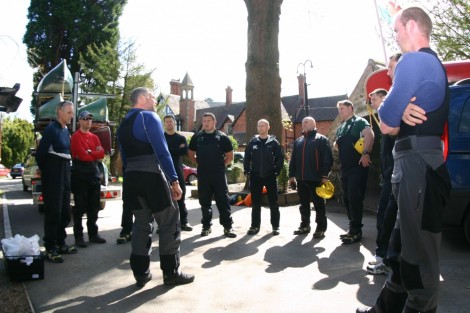
A quick team talk before getting on the water
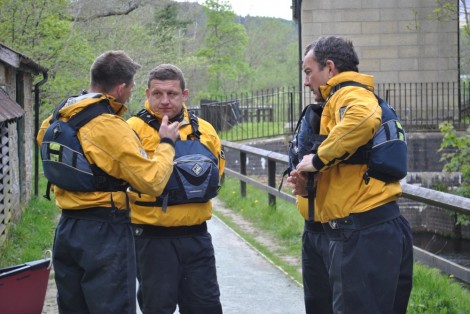
Bish explaining to Hatts and Tony about the finer art of paddling!


A fine body of men! From L-R Me, Justin Bishop, Toby Booth, Tony Cilia and Neil Hatley

Hey guys, doe s my bum look big in this?
You can find out more about our challenge by visiting
www.h4hyukonriverquest.moonfruit.co.uk/#
Please show your support for us by visiting our just giving page
http://www.bmycharity.com/InterserveLondonIrishYUKON
A big thank you to all the following for there help and support in making this happen
Palm Equipment
Desperate Measures
Outdoor Active
Rab Outdoor
UCLAN
I will be wearing a SPOT GPS tracking device throughout the event enabling you follow our progress throughout and will post a link to this later.
Meanwhile back to the maps, sorting equipment and packing! Now where did I put my passport?
See you on the water…..
Jules
www.voyageur-coaching.co.uk
The Lakes is a place I like to try and visit a couple of times a year as I enjoy both the paddling and scenery it has to offer. So whilst on one of my trips earlier this year I took the opportunity to revisit Ullswater whilst introducing a few young kayakers to the delights that open boating has to offer. I felt that paddling the entire length of Ullswater followed by an overnight bivy then a trip down some easy grade moving water of the River Eamont was the way ahead.
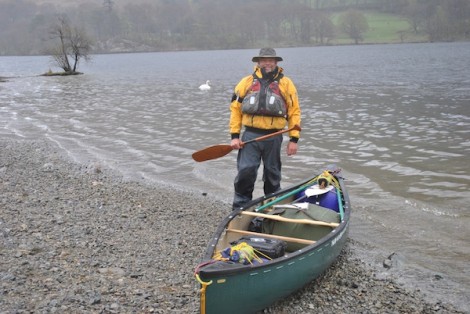
Keep smiling and hopefully the weather will improve..!
Ullswater is the second largest lake in the English Lake District. It is approximately 9 miles long and 0.75 miles wide and has a depth of 60 metres. It is said to be one of the most beautiful of the English Lakes and has been compared to Lake Lucerne in Switzerland. The name Ullswater is said to have possibly originated from a Nordic Cheif ‘Ulf” who ruled the area.
One of Ullswater’s interesting facts is that Sir Donald Campbell set the world water speed record on Ullswater on July 23, 1955, when he piloted the jet-propelled hydroplane “Bluebird K7″ to a speed of 202.32 mph (325.53 km/h).
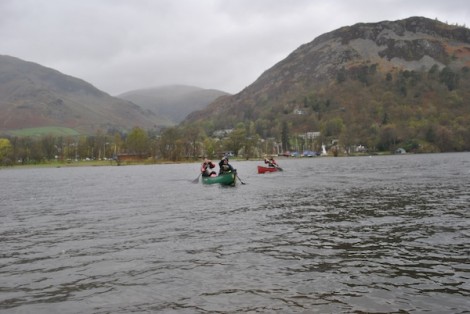
Dark clouds building

Looking back to the Jetty and one of the Steamers that runs trips along Ullswater
We chose to launch at the Southern end of the Lake on the Western shore at the Jetty where the Steamers sail from. Launching here is free although there is a fee for parking. The weather was rather unsettled with strong gusting winds and heavy showers so I was very glad I was wearing my old favorite an Aleutian Cag. Not to be put perturbed by the conditions we set off trying to get some shelter provided by the many surrounding hills. As we paddled across we had a good view down the lake of what was to come on our journey.

Heading over to the Eastern shore seeking shelter
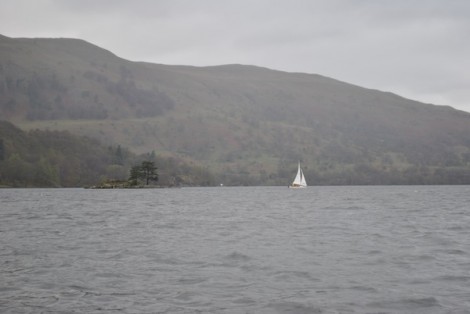
Looking down the Lake
As previously mentioned the winds were quite strong so we decided to harness the effects and rafted our boats together, building a Catamaran style sailing rig. All set and fully briefed with regards safety, man over board etc we were off. The decision was made that due to the speed we were traveling at we would only sail for a short distance so as not to end our days journey by arriving at the end too soon.
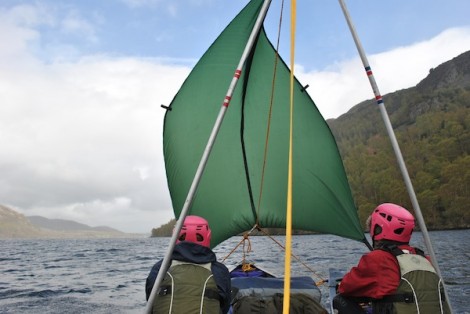
Hoist the mainsail!

My home for the night
We made good time and soon arrived at the far end of the Lake not far from Pooley Bridge. We camped for the night at the Waterside Campsite which I can thoroughly recomend. As usual I opted for a tarp shelter using my boat rather than a tent.
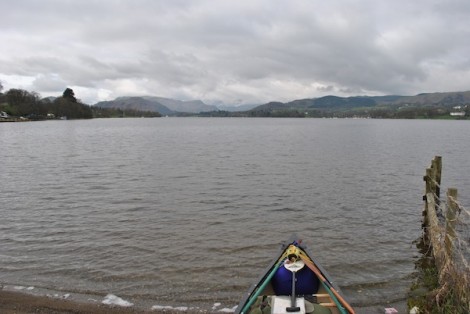
View back up the Lake as we set off
Next morning we set off paddling from the site heading to Pooley Bridge where the River Eamont flows out. This is a very pleasant section of river at a grade 1-2. Overhanging trees being the biggest hazard together with a few weirs, most of which can be run in lower levels but may require inspection at higher levels.
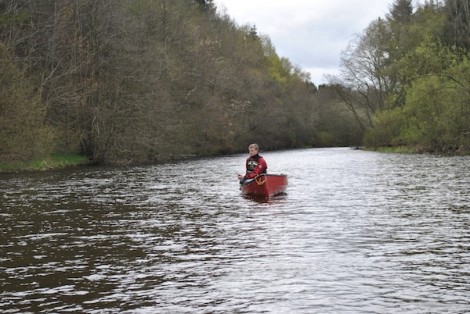
Enjoying some of the flatter sections

Two's company three's a crowd!

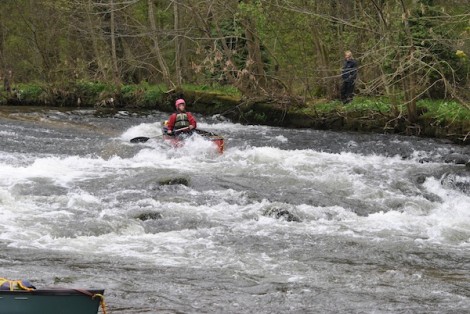

Me thinks you enjoyed that!
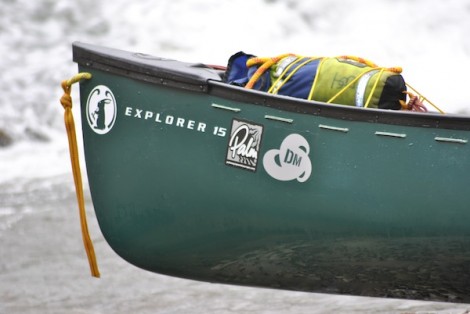
A very photogenic Explorer 15
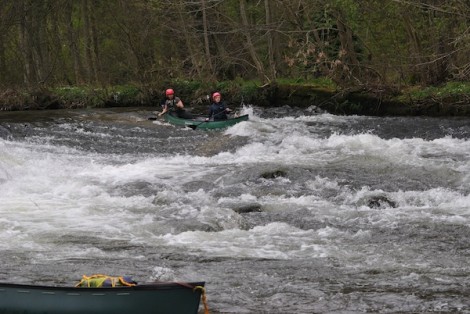
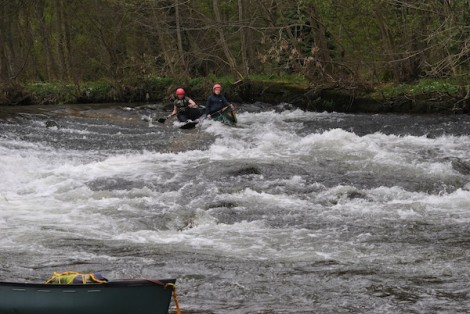

Who's driving?
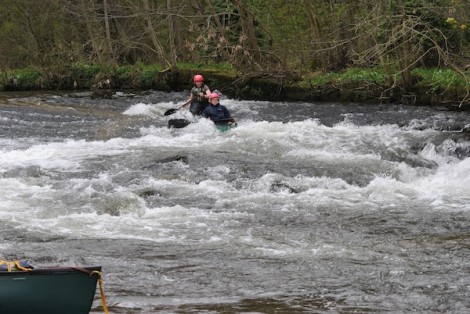

And before you ask, no they didn't!!
A few drops later and it was time for some lunch near the Eamont Bridge before continuing on down to our finish point at Brougham Castle. This section of the River Eamont is approximately 11km with the option of extending the trip further, as the River Lowther now joins leading on a further 7km to where it joins the River Eden.
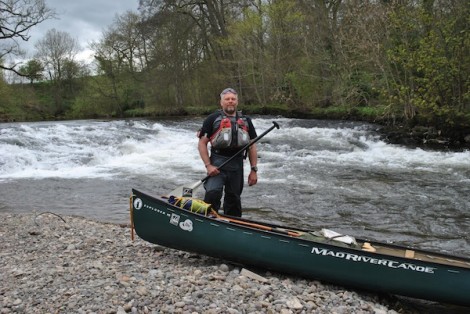
Despite the challenging weather a great couple of days paddling were had. I can thoroughly recommend this trip, but as previously mentioned check the levels before setting off and if in doubt seek some advice. Many thanks to Angus, Maria and Oliva for accompanying me and may be now Ive converted you to wannabe open boaters!
See you on the water…
Jules
www.voyageur-coaching.co.uk
Having paddled open boats of the more traditional variety for many years I recently decided to revisit and explore the world of the White Water Canoe or ‘Spec Boating‘ as it is sometimes referred to.

Early days. Its like learning to paddle again!

I have been the proud owner of a Mad River Outrage for a number of years and have had lots of fun and enjoyment paddling it. Although I will say I did clock up a number of hours trying to roll it! It definitely allowed me to take my White Water paddling into new areas, and gave me some new skills to apply to my traditional style of paddling. The boat seen above is a Spanish Fly and paddling this has been like learning to paddle again from scratch.
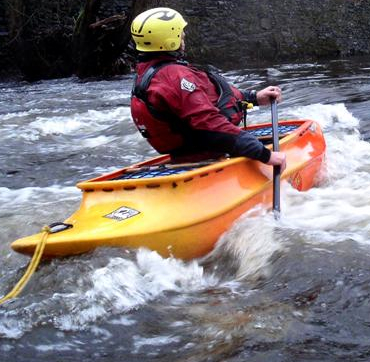
A good stern pry is one of the keys to paddling a WW Canoe
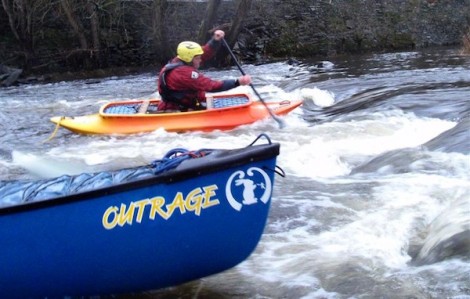
Although still an open canoe these boats take on a somewhat different appearance, being alot shorter in length, have a more pronounced rocker and in some cases quite bold edges. Unlike traditional canoes the boats tend to have a saddle of some form in place of a kneeling thwart together with some kind of strap system to ensure a snug/secure fit and also to allow the boat to be rolled. Another feature of a White water specific specific canoe is that most of the empty space within is occupied by air bags. All these features greatly aid the performance and the fun that can be had by a canoe in a more challenging environment.
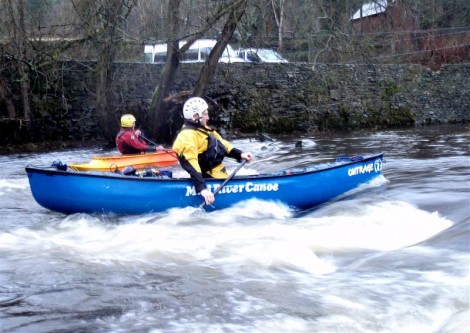
Andy paddling my Mad River Outrage

One of two poses... Either swimming or about to swim!
Having spent more time in it recently its time to move on. In a few weeks I will be visiting the Pyrenees for some trad style boating and hopefully to have some more fun in my WW canoes. Then later this year another trip to the North of Scotland is on the cards. Hope to have some tales of paddling them together with some pictures soon.
See you on the water….
Jules
www.voyageur-coaching.co.uk








































